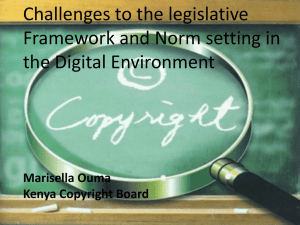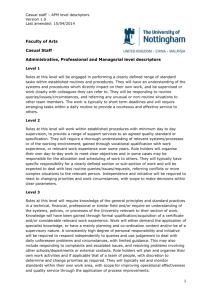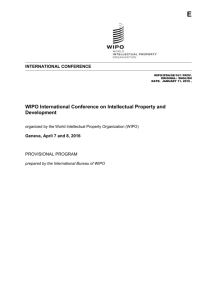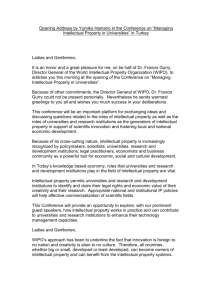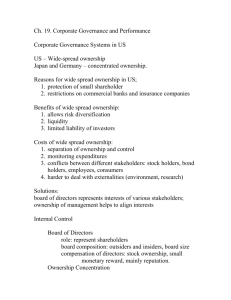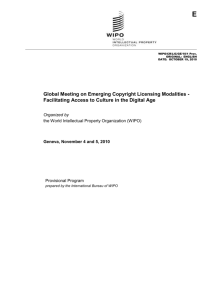framing creations
advertisement
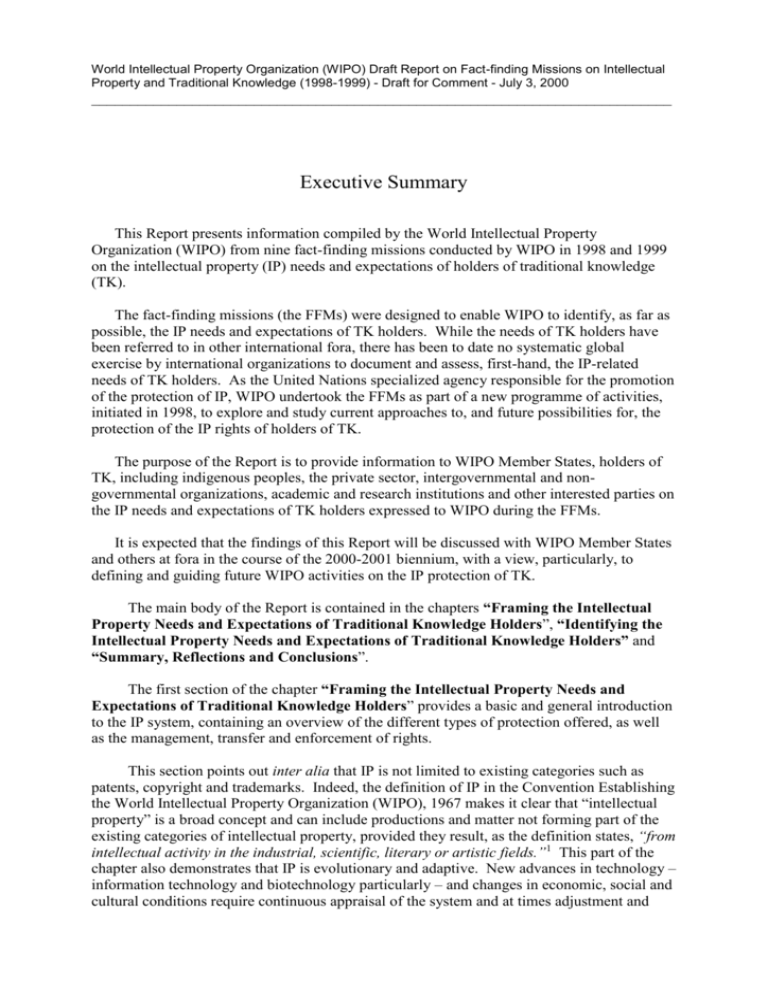
World Intellectual Property Organization (WIPO) Draft Report on Fact-finding Missions on Intellectual Property and Traditional Knowledge (1998-1999) - Draft for Comment - July 3, 2000 ___________________________________________________________________________ Executive Summary This Report presents information compiled by the World Intellectual Property Organization (WIPO) from nine fact-finding missions conducted by WIPO in 1998 and 1999 on the intellectual property (IP) needs and expectations of holders of traditional knowledge (TK). The fact-finding missions (the FFMs) were designed to enable WIPO to identify, as far as possible, the IP needs and expectations of TK holders. While the needs of TK holders have been referred to in other international fora, there has been to date no systematic global exercise by international organizations to document and assess, first-hand, the IP-related needs of TK holders. As the United Nations specialized agency responsible for the promotion of the protection of IP, WIPO undertook the FFMs as part of a new programme of activities, initiated in 1998, to explore and study current approaches to, and future possibilities for, the protection of the IP rights of holders of TK. The purpose of the Report is to provide information to WIPO Member States, holders of TK, including indigenous peoples, the private sector, intergovernmental and nongovernmental organizations, academic and research institutions and other interested parties on the IP needs and expectations of TK holders expressed to WIPO during the FFMs. It is expected that the findings of this Report will be discussed with WIPO Member States and others at fora in the course of the 2000-2001 biennium, with a view, particularly, to defining and guiding future WIPO activities on the IP protection of TK. The main body of the Report is contained in the chapters “Framing the Intellectual Property Needs and Expectations of Traditional Knowledge Holders”, “Identifying the Intellectual Property Needs and Expectations of Traditional Knowledge Holders” and “Summary, Reflections and Conclusions”. The first section of the chapter “Framing the Intellectual Property Needs and Expectations of Traditional Knowledge Holders” provides a basic and general introduction to the IP system, containing an overview of the different types of protection offered, as well as the management, transfer and enforcement of rights. This section points out inter alia that IP is not limited to existing categories such as patents, copyright and trademarks. Indeed, the definition of IP in the Convention Establishing the World Intellectual Property Organization (WIPO), 1967 makes it clear that “intellectual property” is a broad concept and can include productions and matter not forming part of the existing categories of intellectual property, provided they result, as the definition states, “from intellectual activity in the industrial, scientific, literary or artistic fields.”1 This part of the chapter also demonstrates that IP is evolutionary and adaptive. New advances in technology – information technology and biotechnology particularly – and changes in economic, social and cultural conditions require continuous appraisal of the system and at times adjustment and Executive Summary - 2 expansion, accompanied often by controversy. For example, the last few decades have seen the recognition of new forms of IP, such as a sui generis form of protection for plant varieties (in the 1950s and 1960s), patent protection for biological material, plants and animals (in the 1970s and 1980s), a sui generis form of protection for layout designs (topographies) of integrated circuits (1980s), copyright protection for computer software (1980s) and protection for databases and compilations of data (1980s and 1990s). The possible protection of tradition-based innovations and creations by the IP system, the subject of this Report, is a more recently articulated question. The second section of the chapter “Framing the Intellectual Property Needs and Expectations of Traditional Knowledge Holders” describes briefly other multilateral institutions and initiatives in which TK protection has emerged and is being addressed, while the final section presents information, with examples from the FFMs, of how informal IP regimes and customary law are being applied to the protection of TK. The chapter “Identifying the Intellectual Property Needs and Expectations of Traditional Knowledge Holders” contains individual, detailed reports on each of the nine FFMs. The earlier chapter on “Methodology” provides information on how the FFMs were planned, conducted and subsequently reported on. The chapter on Terminology describes certain terms as they are used by WIPO in the Report and in its work. The Chapter seeks less to define such terms, than to provide some clarity and a common basis upon which the Report can be understood. The “Summary, Reflections and Conclusions” chapter seeks to summarize, reflect upon and draw broad conclusions on what may be considered to be the main and most prevalent IP-related needs and expectations expressed to WIPO during the FFMs by TK holders and others with whom WIPO consulted. The main needs and expectations may be summarized as follows: The selection of an appropriate term or terms to describe the subject matter for which protection is sought. A clear definition or description of what is meant (and not meant) for IP purposes by the term or terms selected. The adjustment of expectations through effective awareness-raising as to the role and nature of IP protection in relation to TK. The prevention of the unauthorized acquisition of IPRs (particularly patents) over TK by documenting and publishing TK as searchable prior art, where so desired by the relevant TK holders. An analysis of how prior art is established for purposes of patent examinations in the context of TK. Greater awareness-raising on the IP system, particularly among sectors of society and communities unfamiliar with it, such as indigenous and local communities and Governmental offices not directly involved in IP law and administration. Executive Summary - 3 Greater understanding by the IP community of the perspectives, expectations and needs of TK holders. Facilitation of dialogue and contact between TK holders, the private sector, Governments, NGOs and other stakeholders to assist in development of modalities for cooperation between them, at community, national, regional and international levels. Enhanced participation by the national and regional IP offices and the IP community at large in TK-related processes in which IP issues are raised. Study of the relationship between collectivity of TK and IPRs, more particularly testing of options for the collective acquisition, management and enforcement of IPRs by TK holders’ associations, including the applicability of collective management of IPRs to TK. Study of customary law and informal IP regimes in local and traditional communities, including conclusions relevant for the formal IP system. In the shorter term, testing the applicability and use of existing IP tools for TK protection, through practical and technical community-level pilot projects and case studies; and, provision of technical information and training to TK holders and Government officials on possible options under the existing categories of IP for TK protection. In the longer term, the possible development of new IP tools to protect TK not protected by existing IP tools, the elaboration of an international framework for TK protection, using inter alia the WIPO-UNESCO Model Provisions for National Laws on the Protection of Expressions of Folklore Against Illicit Exploitation and Other Prejudicial Actions, 1982 as a possible foundation, and the development of a sui generis system of “community” or “collective” rights to protect TK. Facilitating access to the IP system, to enable TK holders to use and enforce rights under the IP system. The provision of information, assistance and advice with respect to the enforcement of TK protection. The provision of legal/technical assistance with TK documentation, including information and advice on the IP implications of TK documentation. The provision of IP advice and assistance in respect of legislation, regulations, guidelines, protocols, agreements (including model terms), policies and processes on access to and benefit-sharing in genetic resources. Assistance and training for TK holders in the negotiation, drafting, implementation, and enforcement of contracts. The development and testing, with the close involvement of indigenous peoples and local communities, of “best contractual practices”, guidelines and model clauses for contracts. Awareness-raising on the potential commercial value of TK and the development of tools for the economic valuation of TK. Executive Summary - 4 It is evident that some of the needs and expectations conflict, or reflect competing policy objectives. WIPO has not attempted to mediate the needs or “resolve” conflicts, but rather to report as fully as possible on the information received from FFM informants. WIPO recognises that it cannot address all these needs and a collaborative effort by other relevant organizations and processes would be desirable. The needs as identified pose challenges for the entire IP community – national and regional IP offices, collective management societies, the private sector, NGOs, civil society, consumers, and the international community, including WIPO and its Member States. The needs and expectations as identified do not, therefore, represent a work program for WIPO, although they are reflected in WIPO’s activities relating to TK in the 2000-1 biennium, which was developed based on the information obtained during the FFMs and other activities. These are described at the end of the “Summary, Reflections and Conclusions” chapter. Further exploration of the role of IP in TK protection also requires a technical understanding of IP and application in the specifics of concrete uses of TK. For its part, as the specialized United Nations agency responsible for the promotion of IP worldwide, WIPO is committed to continuing to address conceptual problems and undertake a practical and technical examination of the application of the IP system to various forms of TK in order to provide an informed and realistic analysis of the IP aspects of TK protection. An efficient IP system that protects TK will promote continued creation and innovation based on that knowledge. IP is not only about conferring property rights. It is also about recognition of and respect for the contributions of human creators. From this perspective, IP has a very important role to play in protecting the dignity of holders of TK and, by recognizing property rights in relation to such knowledge, giving those holders a degree of control of its use by others. The protection of TK also benefits third parties, who are able to enjoy access to protected tradition-based innovation and creation that may not be collected, captured in some media, or find channels of distribution without IP protection. The FFMs have shown the richness and diversity of TK on a global scale, both in terms of its inherent creativity and as potential subject matter for IP protection. The IP system cannot, however, respond fully to all the needs of TK holders. Many of the problems encountered by TK holders are less “legal” than “operational” – TK holders (as do some other sectors of society) often lack the know-how and financial resources to take advantage of the IP system, whether in its present or in an evolved form, and they need support in this respect. There are nevertheless certain conceptual difficulties. However, the fact that existing standards of IP may not be in perfect harmony with elements of TK worthy of protection, should not be seen as an insuperable obstacle. IP has consistently evolved to protect new subject matter, such as software and layout-designs, the emergence of which was unforeseeable even twenty years earlier. Copyright protection has been extended to the digital environment. IP is now moving forward to protect databases. Given its evolutionary and adaptive nature, it is not inconceivable that the IP system might provide effective protection for traditional knowledge. 1 Article 2(viii), Convention Establishing the World Intellectual Property Organization, 1967.
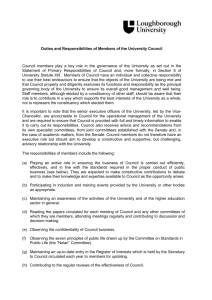
![Invitation [word format]](http://s3.studylib.net/store/data/007096478_1-54334bf5ab877bf1ebd233e686a3f8bb-300x300.png)
